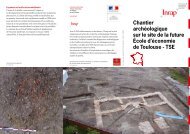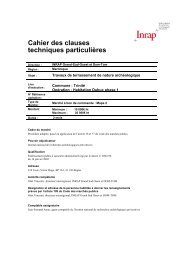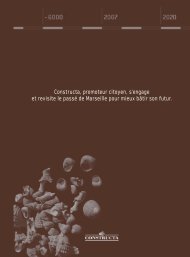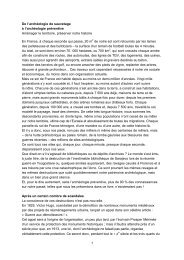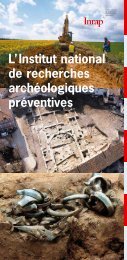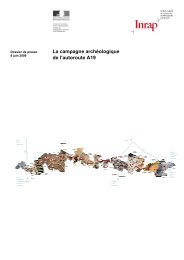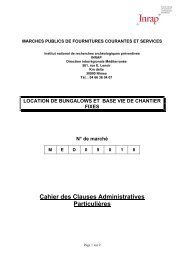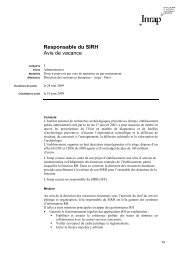Vestiges de la traite négrière - Inrap
Vestiges de la traite négrière - Inrap
Vestiges de la traite négrière - Inrap
Create successful ePaper yourself
Turn your PDF publications into a flip-book with our unique Google optimized e-Paper software.
L’HaBiTaT eT La cULTUre MaTÉrieLLe – 10 Mai 2012<br />
Les rues cases-nègres aux Antilles françaises<br />
Kenneth G. Kelly, University of South carolina, columbia<br />
Pendant <strong>de</strong>ux siècles, <strong>la</strong> production <strong>de</strong><br />
sucre enrichit les colonies <strong>de</strong>s Antilles<br />
françaises. Les vestiges <strong>de</strong> cette<br />
économie, bâtie sur <strong>la</strong> main-d’œuvre<br />
d’Africains asservis, en sont aujourd’hui<br />
les témoignages tangibles en Gua<strong>de</strong>loupe<br />
et en Martinique. Un grand nombre<br />
d’« habitations » y affirme l’étendue et<br />
l’importance <strong>de</strong> <strong>la</strong> production sucrière.<br />
Toutefois, <strong>la</strong> vie <strong>de</strong>s travailleurs asservis,<br />
sans lesquels il était impossible<br />
d’exploiter les habitations sucrières, est<br />
omise <strong>de</strong> l’histoire écrite <strong>de</strong> cette pério<strong>de</strong>.<br />
L’archéologie <strong>de</strong> <strong>la</strong> pério<strong>de</strong> coloniale<br />
permet d’approfondir <strong>la</strong> connaissance<br />
du mon<strong>de</strong> <strong>de</strong>s esc<strong>la</strong>ves, <strong>de</strong> leur vie<br />
quotidienne et <strong>de</strong> <strong>la</strong> manière dont ils ont<br />
survécu à leurs épouvantables conditions<br />
<strong>de</strong> vie. L’archéologie historique révèle<br />
l’histoire cachée <strong>de</strong> ces « personnes sans<br />
histoire » qui travail<strong>la</strong>ient sur trois<br />
habitations sucrières en Gua<strong>de</strong>loupe<br />
et Martinique.<br />
30<br />
Kenneth G. Kelly est professeur d’anthropologie à<br />
l’université <strong>de</strong> Caroline du Sud, où il enseigne l’archéologie<br />
<strong>de</strong> l’époque coloniale et l’archéologie africaine. Depuis une<br />
vingtaine d’années, il abor<strong>de</strong> <strong>la</strong> diaspora africaine et<br />
l’impact <strong>de</strong> <strong>la</strong> <strong>traite</strong> en Afrique <strong>de</strong> l’Ouest et aux Antilles<br />
avec une perspective transat<strong>la</strong>ntique et conduit notamment<br />
<strong>de</strong>s recherches au Bénin, en Guinée, en Jamaïque, en<br />
Gua<strong>de</strong>loupe et en Martinique.<br />
Bibliographie sélective<br />
• K.G. Kelly, M.D. Hardy, French Colonial Archaeology in<br />
the Southeast and Caribbean, University Presses of<br />
Florida, Gainesville, 2011.<br />
• K.G. Kelly, “Archaeological Perspectives on the At<strong>la</strong>ntic<br />
S<strong>la</strong>ve Tra<strong>de</strong>: Contrasts in Time and Space in Benin and<br />
Guinea”, S<strong>la</strong>very in Africa: Archaeology and Memory,<br />
Oxford University Press.<br />
• K.G. Kelly, “Where is the Caribbean? French Colonial<br />
Archaeology in the English Lake”, International Journal of<br />
Historical Archaeology, 2009.<br />
• K.G. Kelly, “P<strong>la</strong>ntation archaeology in the French West<br />
Indies”, Archéologiques, 2008.<br />
• K.G. Kelly, “Historical Archaeology in the French<br />
Caribbean”, Journal of Caribbean Archaeology, 2004.



